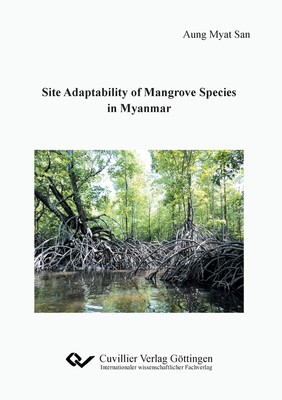
- We will send in 10–14 business days.
- Author: Aung Myat San
- Publisher: Cuvillier
- Year: 2020
- Pages: 292
- ISBN-10: 3736971516
- ISBN-13: 9783736971516
- Format: 14.8 x 21 x 1.6 cm, softcover
- Language: English
- SAVE -10% with code: EXTRA
Reviews
Description
Mangroves play an important role in the sustainability of marine ecosystems and provide protective and productive services for the socio-economic development of coastal communities. However, the degradation of the world's mangroves is severe, and restoration of this unique ecosystem is of global concern. In this light, site-species matching is crucial for successful mangrove reforestation. Understanding the physiological responses of mangroves to limiting ecological factors is essential in selecting site-specific species. Salinity, intertidal dynamics and waterlogged site conditions are the abiotic factors limiting the distribution and growth of mangroves. To cope with the harsh environment, mangroves perform various strategies including osmoregulation, salt secretion, salt storage, aerial root or pneumatophore development and regeneration by vivipary propagules. If the intertidal gradient is favorable, mangroves distribute according to the typical zonation pattern. Saturated leaf osmotic potential and sapwood osmotic potential can be used as site indicators. The pneumatophores of mangrove perform well for gas exchange under waterlogged soil and oxygen limitation could be neglected in species selection. Additionally, participation of local communities is fundamental for the sustainable management of mangrove resources. Planting the optimally-suited species at a given site is highly recommended for the successful restoration of mangrove ecosystems. This book should prove useful in the selection of suitable mangrove species for planting across a range of intertidal zones.
EXTRA 10 % discount with code: EXTRA
The promotion ends in 20d.01:58:53
The discount code is valid when purchasing from 10 €. Discounts do not stack.
- Author: Aung Myat San
- Publisher: Cuvillier
- Year: 2020
- Pages: 292
- ISBN-10: 3736971516
- ISBN-13: 9783736971516
- Format: 14.8 x 21 x 1.6 cm, softcover
- Language: English English
Mangroves play an important role in the sustainability of marine ecosystems and provide protective and productive services for the socio-economic development of coastal communities. However, the degradation of the world's mangroves is severe, and restoration of this unique ecosystem is of global concern. In this light, site-species matching is crucial for successful mangrove reforestation. Understanding the physiological responses of mangroves to limiting ecological factors is essential in selecting site-specific species. Salinity, intertidal dynamics and waterlogged site conditions are the abiotic factors limiting the distribution and growth of mangroves. To cope with the harsh environment, mangroves perform various strategies including osmoregulation, salt secretion, salt storage, aerial root or pneumatophore development and regeneration by vivipary propagules. If the intertidal gradient is favorable, mangroves distribute according to the typical zonation pattern. Saturated leaf osmotic potential and sapwood osmotic potential can be used as site indicators. The pneumatophores of mangrove perform well for gas exchange under waterlogged soil and oxygen limitation could be neglected in species selection. Additionally, participation of local communities is fundamental for the sustainable management of mangrove resources. Planting the optimally-suited species at a given site is highly recommended for the successful restoration of mangrove ecosystems. This book should prove useful in the selection of suitable mangrove species for planting across a range of intertidal zones.


Reviews